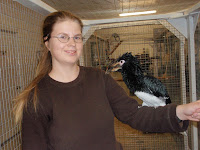What’s black, brown and yellow, great at playing follow the leader, and Buddy the Double Yellow Headed Amazon’s best friend? Our Chickens, aka Black, Brown and Yellow! Yes these eggcellent little Bantam Cochin chickens are quite the crowd pleasers at WBS’s Milwaukee County Zoo bird show, not too bad for a trio of two year olds.
Black, Brown, and Yellow (yes those are their names) have been doing shows for their whole lives and each one has their own personality. Black never bawks at a challenge and anytime she can jump on or squeeze under something for food, she’s all for it. Brown is very quick at catching onto behaviors and does most of the egg laying in the group. Yellow gets frightened easily and may appear to not understand a behavior right away, but she’s also the one who realized she didn’t have to follow us around the ETC, and that she could run back into the pen and wait for the food to return. All three love to pile up together at night, and have recently discovered that fruit is tasty and not frightening. Now we just have to introduce them to greens, which are a favorite of fellow Cochins Dumpling and Daisy.
Bantam Cochin chickens are a breed native to Asia, and many people keep them as pets. After watching these three trail along after us I can certainly understand why. They are great pest controls in gardens, eating unwanted insects with relish. In fact they have specially adapted feathers that cover their feet (and look kind of like pantaloons) that help them to sense the vibrations of insects in the soil. The Chickens are also prolific egg producers, usually laying one or two eggs every other day. Not only do they produce fresh eggs, but they also produce some of nature’s very best organic fertilizer. Best of all is the eggciting fact that chickens can be trained.
Black, Brown and Yellow know a variety of behaviors. They are great at following us between their indoor and outdoor pens at the zoo. Black and Brown can spin in circles on cue (in opposite directions) and Black will fly up to a trainer’s arm. Last year, in the Milwaukee Count Zoo bird show, they had a fairly simple pattern. They ran from one part of the stage, up a ramp, and back into their pen. This year we are having a little more fun, although the basic A to B pattern is still there--we didn’t need to start from scratch after all. In addition though, Black is also playing the role of our chicken hawk. Imagine you are an unsuspecting child volunteer, waiting with arm outstretched to receive the chicken hawk you’ve been told is going to land on you. Suddenly from out of nowhere there is a small black chicken on your arm eating grapes from the show speaker’s hand. Pretty fowl right? Black does an excellent job of surprising and then delighting children in shows while Brown and Yellow run around excitedly at their feet. Then all three chickens run off the stage and back to their pen while the audience cracks up.
Many people love the Chickens, perhaps because they are small and run in an amusing waddling gallop. Or maybe it’s because black jumps onto a child’s arm and the other two wait before all three leave. For whatever reason, they are eggceptional people pleasers and definitely a lot of fun to work with and train.
....AND THAT’S NO YOLK!
....AND THAT’S NO YOLK!





No comments:
Post a Comment